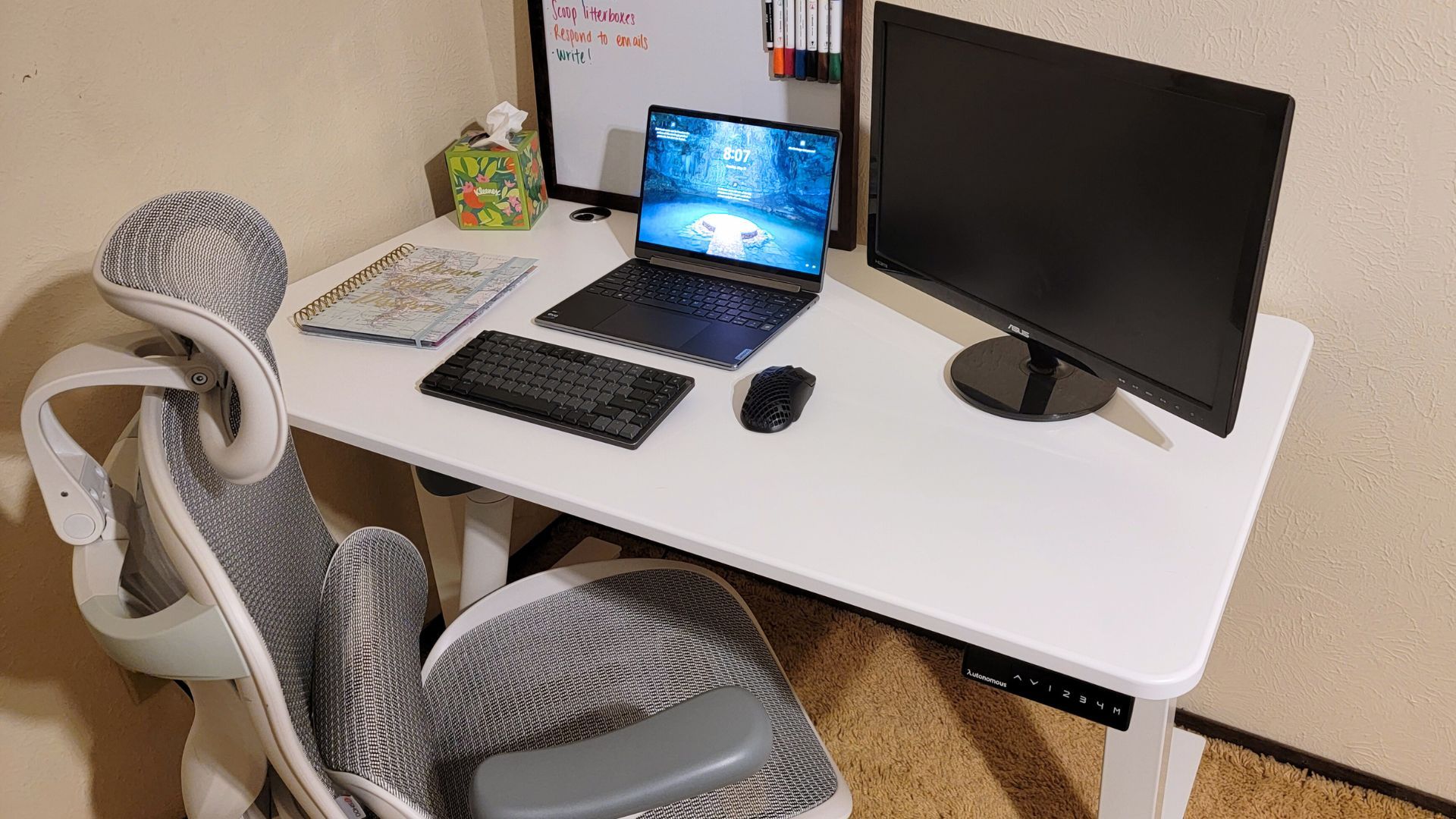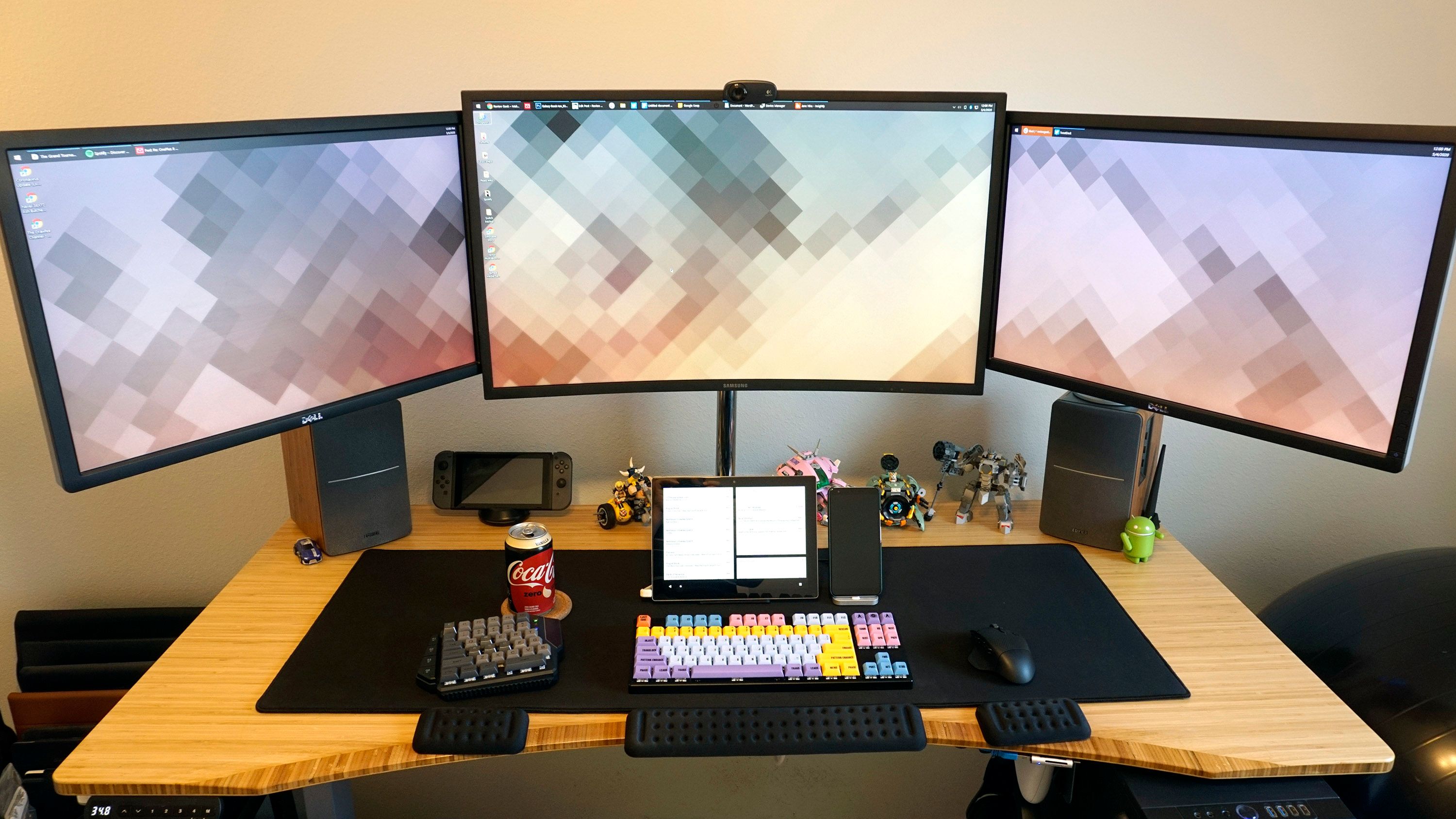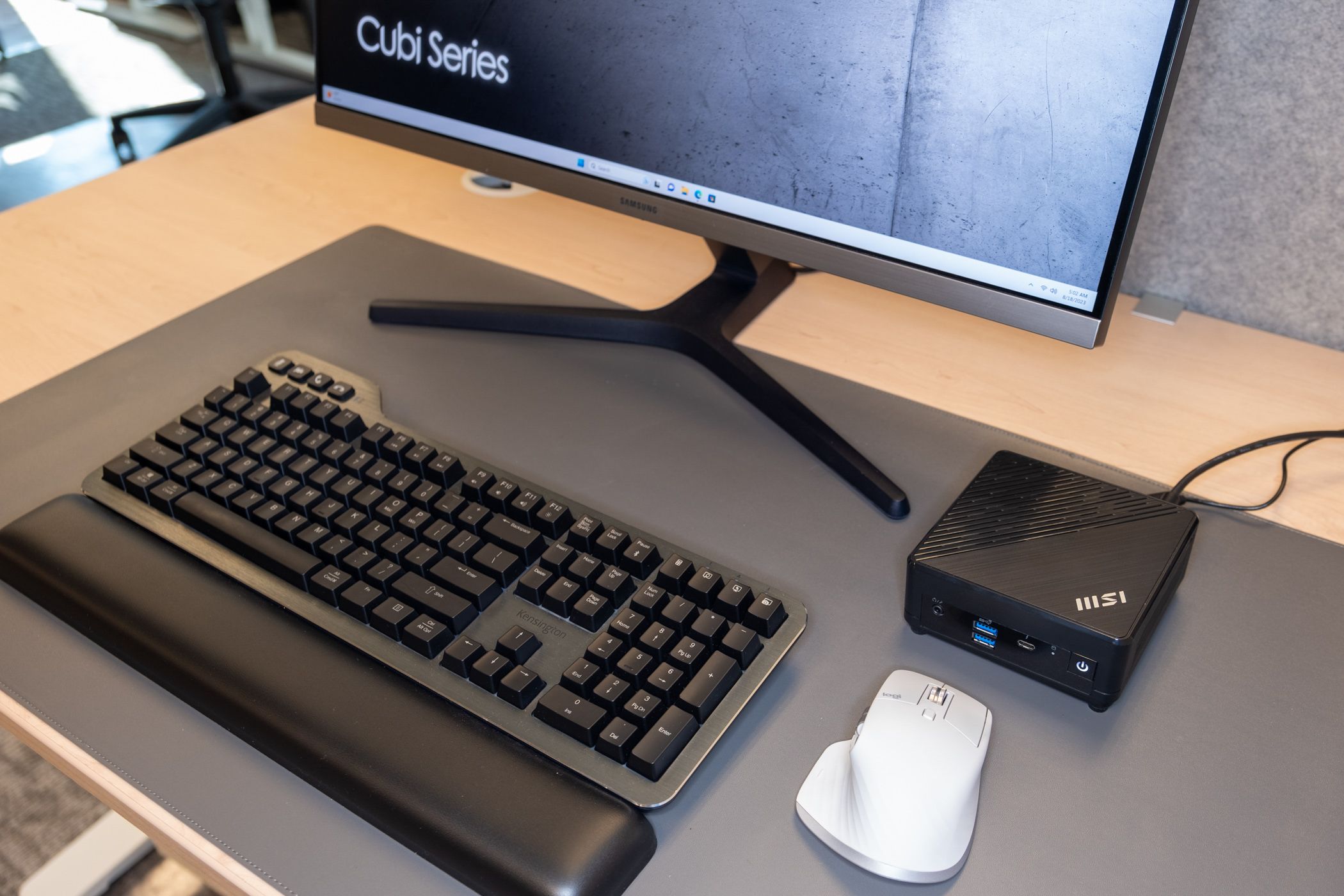Like most people, I wasn’t remotely prepared to work from home before the pandemic. I had done it before—but fixing computers, not living my professional and personal lives through one. Here are some lessons I learned along the way.
1. Go All-In on Ergonomics
Working in person at a newsroom, I shared furniture with dozens of colleagues, spanning three different shifts. Nothing remains in pristine condition for too long that way. We all found out, however, that the office furniture was a slice of heaven compared to what we had at home. Have you ever tried staying 5 hours or more sitting at your dinner table, five days a week?
People with more spacious homes may enjoy the benefits of a fully equipped study, but most of us living in small apartments barely have space for a twin bed. However, a good office chair takes virtually the same space as a cheap one. The same applies to a working desk.
Sarah Chaney / Review Geek
That’s not just to boost productivity, though the difference will be immediately noticeable. Your health might improve as well, especially if you suffer from posture-related pain. That may lead to a more restful sleep, a better mood, and so on.
But don’t just get any desk and any chair. The international standard for office furniture ergonomics exists for a reason, and even good-quality furniture isn’t 100% ergonomic by itself. Remember to match desk and chair heights when you go shopping—a measuring tape helps with that.
The rules of thumb are:
- Knees at 90 degrees when your feet are on the floor;
- Elbows at 90 degrees with your forearms in the typing position;
- Straight spine with your lower back completely supported by the chair’s backrest;
- Eyes facing the center of the screen (that possibly means using a laptop base or a monitor support).
There’s a chance that your posture has been wrong for so long that your body has grown used to it. Undoing that damage isn’t easy, but it’s important.
2. Don’t Neglect Your Health
Ergonomics is step one, but that’s just it: step one. Keeping a water bottle nearby can be all you need to remember to drink from it. A walk every couple of hours or so can also do wonders. Don’t hold your bladder “just to the end of this paragraph”—you’ll find another paragraph after it, and another, and another, and then 3 hours have gone by.
Tired african American millennial female worker sit at desk touch back suffer from lower spinal spasm, hurt unhealthy biracial woman stretch have strong backache, incorrect posture concept
Also, when working from home, it’s easy to make our work the most pressing part of our lives—I made that mistake too many times. But, just because your workstation is always close (possibly even at sight), that doesn’t mean you’re always on the clock.
I only put my health above my job after needing three different types of doctors just to assess the damage. Had I done exercises, eaten more decently (you have that lunch break for a reason), and gone out for a walk occasionally, I’d be in far better shape.
3. Respect Your Work Hours
Related to health is work hours; when working from home, it’s very easy to do overtime. If the “work hours’ mindset” is active from when you wake up till you go to bed, it might be a good idea to hit the brakes. Avoiding commute traffic is a blessing, so why fill the saved time with more work?
Most people have 9 to 5 jobs or per-project ones, with flexible hours. Having a well-defined routine helps in both cases. What worked best for me was to define a weekly schedule and follow it to the letter.
There are tricks to ensure you do. The one that helped me most during these years is not having my workstation in my bedroom. You don’t need to have a study to do that; if there’s enough space in your living room, I suggest you try moving your desk and computer there.
4. Prioritize Hardware That Boosts Productivity
Speaking of productivity, investing in the right hardware really helps you get your work done better and faster. Sometimes, this comes from unexpected places.
When I started writing, my job required having dozens of tabs open. My computer back then wasn’t making the cut. Upgrading memory and storage helped until I saved enough for a great laptop. Further upgrades—secondary screens and a mechanical keyboard—mean I sometimes get double the work done, compared to early 2020.
But those were the devices that helped in my specific situation. You’ll need hardware that helps with the tasks your job requires. Here are a few examples.
Also, some occupations may require hardware not needed by others. A musician will surely benefit from professional-grade headphones, but, if you own an online store, a nice lighting kit for product photos is probably of higher priority.
5. Software Is Important, Too!
Having great equipment won’t be of much help if you don’t use software to support it. We won’t suggest apps for each and every professional out there. Instead, we’ll list solutions more widely aimed at productivity.
While many people would rather use a pen and paper solution, I also suggest having a note-taking app always at hand on your computer or your phone—even better, one that syncs between both devices. I personally favor the todo.txt system, with the text file stored in OneDrive.
There are organization programs as well. I personally can’t do a thing without a tiling manager like Rectangle, the OneTab aggregator, or custom keyboard shortcuts.
The best way of finding out what apps you need is listing what breaks your workflow and searching for solutions to prevent that from happening. Is it looking for a notepad among your desk clutter? Try using notes apps. Have a multi-monitor setup, but windows get messed up every time you lock the screen to grab a coffee? A window manager may help. Do you struggle to focus but can’t even remember to breathe when you get “in the flow”? Give pomodoro timers a shot.
Lastly, people working with different operating systems (OSes) will need different apps. Some online solutions that are OS-agnostic, but many times you need to do things locally. Luckily, folks at GitHub have curated lists of programs for Windows, macOS, and Linux, so you’ll not be underserved.
6. You Can’t Work in an Environment That Doesn’t Work
Possibly the most underrated thing I learned working from home is that ambiance is paramount. Not everything is under your control—you can’t dial your noisy neighbors’ volume down. But some are—with air conditioning, you can shut the windows without suffocating, and their loud music won’t disturb your work (or rest) too much.
In shared offices, compromises have to be made, so everyone enjoys a welcoming workplace. The chances that everyone will agree on the thermostat position are just null, and the same applies to light intensity, soundtrack, and so on. Working from home robs you of human interaction, but offers near total control over the ambiance. So don’t waste it!
Do you want natural lighting? Pull the curtains all the way. Prefer something more cozy? Indirect lamps work just fine. Want complete silence? Use ANC headphones to shut the outside world—you won’t have to worry about people poking your shoulder for a “five-minute talk” that’s actually a two-hour meeting. If you function better with a playlist blasting at the maximum volume, there are no coworkers to complain about it (but your neighbors might, so don’t dismiss the headphones’ idea just yet).
7. Consider Working From Home but Not From Home
The major downside for most of the previous tips is that they often require a (sometimes considerable) investment. But there are ways to skip some of those, for starters at least.
Most people consider “remote work” and “working from home” synonymous, but this doesn’t need to be the case. Digital nomadicity doesn’t require traveling light, but probably the sole thing you’ll need to do your job on the go is a laptop.
For instance, consider a coworking space if you want a place that’s yours but doesn’t need it to be completely yours. You’ll still run into some office issues, like the occasional fight over room temperature, but not others—you can choose where you’ll work, for starters.
There are free options, too, like libraries, college study rooms, and coffee shops. For the latter, I just advise you avoid places that are too good, or you risk spending more on beverage than you’d by renting a coworking station (which usually have free coffee).
Open spaces may also be a possibility. People working for companies like Apple or Google, from C-level to operational staff, always talk about how important the green areas are. So, why not take your job to a park? Birds singing, cool breeze, you can even go jogging after your lunch break.
Your Best Self for Remote Work Is Your Best Self
Remote jobs require the most attention to balancing work and personal lives. You can punch in and go make a coffee, but you may also have to leave the shower halfway through to finish an urgent task.
Because of this, increasing productivity while working from home may mean increasing productivity and well-being at home as a whole. And that may help you become your best self—not just for work.
source





